This is a summary of a report on trends in violence since the dawn of humanity: from the hunter-gatherer period to the present day.[1] The full report is available at this Substack and as a preprint on SSRN.[2] Phil did 95% of the work on the report.
Expert reviewers provided the following comments on our report.
“Thomson and Halstead have provided an admirably thorough and fair assessment of this difficult and emotionally fraught empirical question. I don’t agree with all of their conclusions, but this will surely be the standard reference for this issue for years to come.”
Steven Pinker, Johnstone Family Professor in the Department of Psychology at Harvard University
“This work uses an impressively comprehensive survey of ethnographic and archeological data on military mortality in historically and archeologically known small-scale societies in an effort to pin down the scale of the killing in the pre-agricultural world. This will be a useful addition to the literature. It is an admirably cautious assessment of the war mortality data, which are exceptionally fragile; and the conclusions it draws about killing rates prior to the Holocene are probably as good as we are likely to get for the time being.”
Paul Roscoe, Professor of Anthropology at the University of Maine
Epistemic status
We think our estimates here move understanding of prehistoric violence forward by rigorously focussing on the pre-agricultural period and attempting to be as comprehensive as possible with the available evidence. However, data in the relevant fields of ethnography and archeology is unusually shaky, so we would not be surprised if it turned out that some of the underlying data turns out to be wrong. We are especially unsure about our method for estimating actual violent mortality rates from the measured, observable rates in the raw archeology data.
One of us (Phil) has a masters in anthropology. Neither of us have any expertise in archeology.
Guide for the reader
If you are interested in this study simply as a reference for likely rates/patterns of violence in the pre-agricultural world, all our main results and conclusions are presented in the Summary. The rest of the study explores the evidence in more depth and explains how we put our results together. We first cover the ethnographic evidence, then the archeological evidence. The study ends with a more speculative discussion of our findings and their possible implications.
Acknowledgments
We would like to thank the following expert reviewers for their extensive and insightful comments and suggestions, which have helped to make this report substantially better.
- Steven Pinker, Johnstone Family Professor in the Department of Psychology at Harvard University
- Robert Kelly, Professor of Archeology at the University of Wyoming
- Paul Roscoe, Professor of Anthropology at the University of Maine
We would also like to thank Prof. Hisashi Nakao, Prof. Douglas Fry, Prof. Nelson Graburn, and Holden Karnofsky for commenting, responding to queries and sharing materials.
***
Around 11,000 years ago plants and animals began to be domesticated, a process which would completely transform the lifeways of our species. Human societies all over the world came to depend almost entirely on farming. Before this transformative period of history, everyone was a hunter-gatherer. For about 96% of the approximately 300,000 years since Homo sapiens evolved, we relied on wild plants and animals for food.
Our question is: what do we know about how violent these pre-agricultural people were?
In 2011 Steven Pinker published The Better Angels of Our Nature. According to Pinker, prehistoric small-scale societies were generally extremely violent by comparison with modern states. To argue this point, Better Angels drew on the work of a variety of anthropologists, archeologists and historians of violence, such as Stephen LeBlanc, Azar Gat, Richard Wrangham and Samuel Bowles. In particular, much of the prehistoric data came from Lawrence Keeley's widely cited 1996 book War Before Civilization.
The success of Better Angels has led to it becoming the go-to source for non-specialists for data on prehistoric violence (it is the principal source for the prehistoric violence section of Our World in Data for example).
Pinker’s comparative and data-driven approach to the study of prehistoric violence is admirable. However, Pinker’s main aim is to compare violence in non-state vs state societies, rather than to rigorously estimate rates of violence in the pre-agricultural period. As a source for likely rates of violence in the pre-agricultural period, the figures in Better Angels can now be improved upon, not least because some important studies on the topic, and new data, have come out since the book's publication
In order to understand what human society was like before agriculture we need to take into account the transformative effect the invention and adoption of farming had on human societies everywhere. Most ethnographic and archeological studies of small-scale societies have little relevance to the question of pre-agricultural violence since most concern people who subsist mainly by farming. 96% of human history happened prior to the agricultural revolution; if we only focus on the last 4% of human history, we will get a distorted picture of patterns and long-term trends in human violence.
The main sources of evidence are ethnographies of recent hunter-gatherer societies, and archeology.
It is important to bear in mind that there are significant issues of reliability for both the ethnographic and archeological data. These reliability issues are discussed in detail later in this study, and have crucial implications for our recommended interpretations of the following data.
The chart below shows rates of lethal violence among those ethnographically observed hunter-gatherer groups who are most likely to be representative of our pre-agricultural ancestors:
Figure ES1.
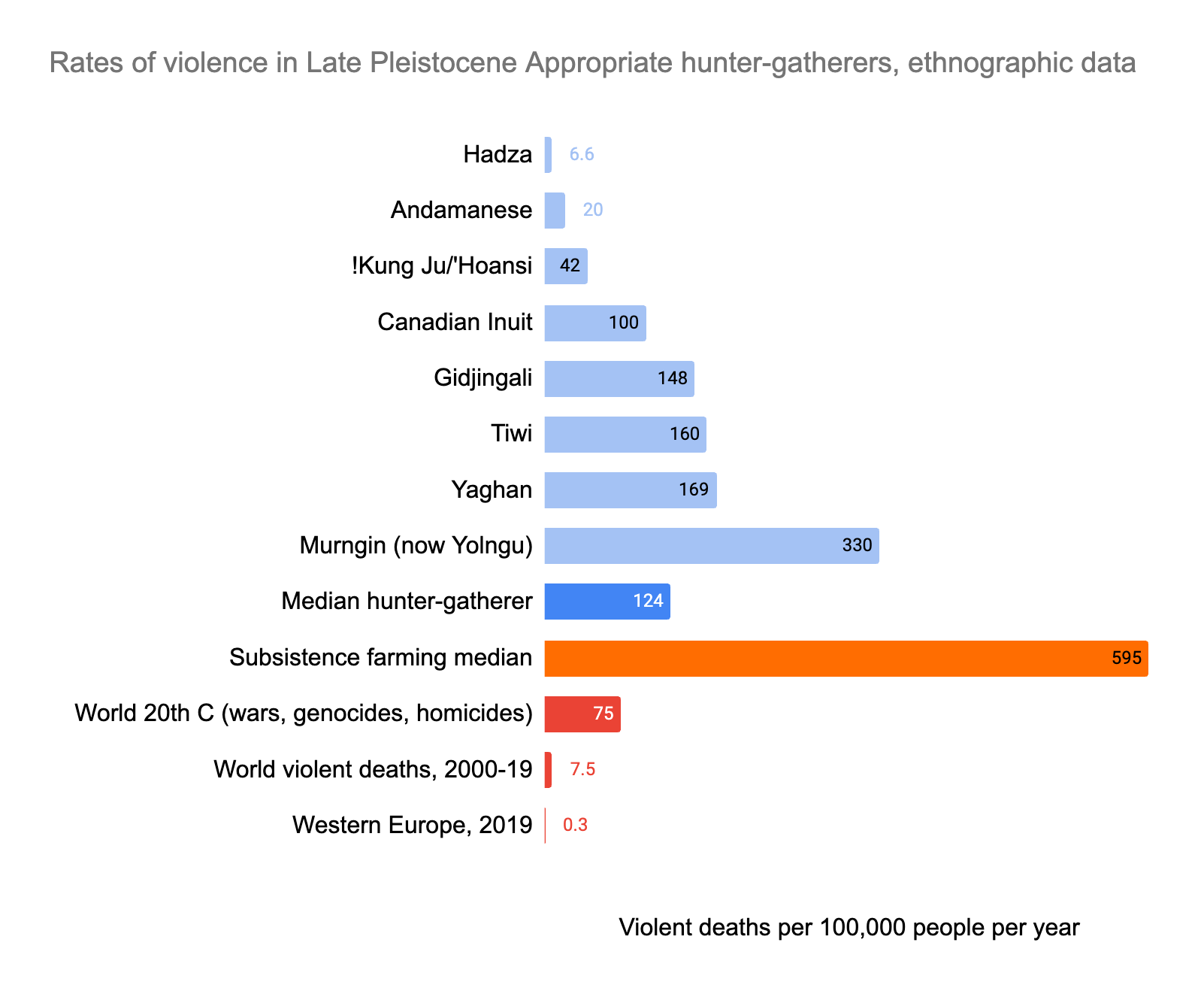
Source: Hunter-gatherer data spreadsheet, ‘Deaths/100k ethnographic’ tab
*The subsistence farming ethnographic dataset is for small-scale societies only and includes some groups often classed as ‘hunter-horticulturalists’, where hunting is combined with farming
Turning to the archeological data, the chart below shows the percentage of skeletons from each period exhibiting archeologically detectable signs of lethal violence. Note that this is a different measure to the one used above, of deaths per 100,000 people per year. [3]
Figure ES2.
Source: Hunter-gatherer data spreadsheet, ‘Adjusted archeology % deaths from violence’ tab
*The relatively high rates estimated for the End-Paleolithic and Total Paleolithic are almost entirely due to a single site, Jebel Sahaba
*The early agricultural archeological dataset consists of non-state agricultural societies from the early millennia following the adoption of agriculture; in a European context they would be described as ‘Neolithic’
However, the archeological evidence understates the actual level of violence in different periods because not all violent attacks would leave detectable marks on the skeleton and evidence of lethal violence can disappear due to issues of preservation. Below are our estimates for actual rates of lethal violence after attempting to adjust for these factors (our methodology for making these adjustments is explained in the archeology section):
Figure ES3.
Source: Hunter-gatherer data spreadsheet, ‘Adjusted archeology % deaths from violence’ tab
*The relatively high rates estimated for the End-Paleolithic and Total Paleolithic are almost entirely due to a single site, Jebel Sahaba
*The early agricultural archeological dataset consists of non-state agricultural societies from the early millennia following the adoption of agriculture; in a European context they would be described as ‘Neolithic’
The methodology to adjust the figures above necessarily involved a good deal of guesswork and is admittedly non-standard. They should therefore be approached with a good deal of scepticism. Nevertheless we feel compelled to attempt these adjustments in order to make the archeological data more potentially useful and to make it comparable to the ethnographic data and data on violence from modern periods.
The chart below compares our archeological and ethnographic data using the common metric of ‘violent deaths per 100,000 people per year’ (which is preferable to ‘% deaths from violence’ as an indication of how violent a population is). It also includes data on the modern world for comparative purposes.
Figure ES4.
Source: Hunter-gatherer data spreadsheet, ‘Final simplified deaths/100k’ tab
*The subsistence farming ethnographic dataset is for small-scale societies only and includes some groups often classed as ‘hunter-horticulturalists’, where hunting is combined with farming
*The early agricultural archeological dataset consists of non-state agricultural societies from the millennia following the adoption of agriculture; in a European context they would be described as ‘Neolithic’
*The early agricultural archeological dataset has been converted into ‘violent deaths per 100,000’ using the same methodology as the pre-agricultural dataset. This is problematic since this methodology assumes that early agriculturalists had the same mortality rate as pre-agricultural people. However, we are not currently aware of a more appropriate mortality rate estimate to use for this conversion
*The pre-agricultural archeological dataset combines data from both the Paleolithic and early Holocene
In order to make this comparison it was necessary to convert the archeological data from ‘% deaths from violence’ into ‘violent deaths per 100,000 people per year’. We did this by using an ethnographic study of average modern hunter-gatherer mortality rates. How accurate this methodology is therefore depends on how similar pre-agricultural mortality rates were to those of modern hunter-gatherers.
Our main conclusions are:
- High degree of uncertainty. Both the ethnographic and archeological evidence should be considered very unreliable. The archeological evidence is sparse, fragmentary, lacks a global perspective and requires estimates involving a lot of guesswork to get figures for actual lethal violence rates. Good ethnographic data for rates of violence among hunter-gatherers is also very thin on the ground and extrapolating the behaviour of ethnographically documented hunter-gatherers into the prehistoric past is problematic in a number of ways. Confident estimates about average levels of violence in the pre-agricultural world therefore are misleading given the currently available evidence and should be avoided.
- Archeological evidence for the Paleolithic is particularly unreliable. There are very few Paleolithic skeletons, particularly for the earlier Paleolithic: only 154 skeletons in our dataset predate 14,000 Before Present (BP) and just a handful predate 50,000 BP. Moreover, Paleolithic skeletons are poorly preserved. There are far more skeletons from pre-agricultural societies in the Holocene: in our sample, out of 13,732 skeletons from the pre-agricultural period, 12,877 date from the Holocene. However, Holocene hunter-gatherers may have differed from their Paleolithic forebears in systematic ways. Still, since the sample from the Holocene is much larger, we think that the total pre-agricultural average is probably more reliable than the Paleolithic average.
- Violence was highly variable. It is likely that pre-agricultural patterns of violence varied dramatically by time and place, and levels/patterns of lethal violence may have differed between pre-agricultural populations by orders of magnitude. The behaviour of Homo sapiens is uniquely plastic and variable. Both the ethnographic record of modern hunter gatherers and the archeological evidence illustrate this variability among pre-agricultural populations.
- Estimates for pre-agricultural rates of violence in Better Angels are much too high. In his widely cited study of violence The Better Angels of Our Nature Steven Pinker estimated that around 15% of deaths in pre-historic small-scale societies were due to violence. Both our ethnographic and archeological data indicate this estimate to likely be much too high for pre-agricultural populations. Our estimates are likely to be more accurate primarily because (a) our ethnographic evidence is restricted only to those hunter-gatherer groups who are the most likely analogues for pre-agricultural populations, and (b) our archeological datasets are much more comprehensive, exclude farming populations and are adjusted to reflect biases in the fossil record.
- Rates of violence for pre-agricultural Homo sapiens were high by comparison to most animal species. Primates (like us) typically exhibit high rates of conspecific lethal violence by comparison to most other groups, and we seem on the high end of the primate spectrum. Gomez et al (2016) show that the phylogenetic tree of species would predict a rate of conspecific lethal violence among Homo sapiens of about 2%.[4] The ethnographic and archeological evidence indicates a significantly higher rate among pre-agricultural populations. We hypothesise that these relatively high rates are due to an unusual suite of factors that make violent conflict among our species highly likely to result in a lethal outcome (rather than, for example, a high frequency of conflict or a particular proclivity for lethal violence).
- Agriculture significantly increased levels of lethal violence. The ethnographic and archeological evidence suggests that early farmers typically exhibited significantly higher levels of lethal violence than pre-agricultural hunter-gatherer populations.
- The increase in lethal violence brought by the agricultural revolution was probably due to increased levels of intergroup conflict (warfare). There are theoretical reasons to think that nomadic hunter-gatherers will engage in warfare less than farmers. For instance, nomadic hunter-gatherers do not store food, and do not have fixed settlements, which makes fleeing relatively easy. Both the ethnographic and archeological evidence bears this out. Ethnographically observed nomadic hunter-gatherers typically exhibit relatively low rates of warfare relative to other societies. The earliest clear archeological evidence of warfare comes from Jebel Sahaba around 14,000 BP, right at the end of the Paleolithic period, when populations were becoming more sedentary. However, the fossil record prior to 14,000 BP is very sparse, so it is hard to be very confident that warfare was indeed rare throughout the Paleolithic.
- The most common proximate motivations for violent conflict were probably disputes over women and desire for revenge. These emerge consistently and cross-culturally as the most common motivations for both interpersonal and intergroup conflict in the ethnographic evidence. However it is likely that contextual factors such as resource stress and cultural differences were also important. Establishing the ultimate causes of violent conflict is complex because of the multilevel/multifactorial nature of motivations for violence.
- The evidence suggests that the 20th and 21st Centuries had lower rates of lethal violence than pre-agricultural times. Despite its wars and genocides, the 20th Century has lower rates of lethal violence than ethnographically-observed and archeologically-observed hunter-gatherers: lethal violent mortality rates among the median hunter-gatherers in our sample are about 1.7x higher than the 20th Century, while the archeological data suggests that the difference is around 1.4x. Moreover, the pre-agricultural period had rates of lethal violence that were upwards of 13-fold higher than 2000-2019. It is reasonable to interpret this evidence as supporting one of Pinker’s central theses in Better Angels. However, we think that there are two caveats to this, though Steven Pinker believes these points to be speculative.
- Regarding the comparison with the 20th Century, one potentially confounding factor to consider is that people in the 20th Century had access to better medical care than hunter-gatherers. Once we adjust for better medical care, we think it is not obvious whether hunter-gatherer societies actually were more violent than the 20th Century (even though they had higher rates of lethal violence).
- The 21st Century so far is only a small snapshot of time, and future catastrophes such as wars and genocides may drag up the rate of violence, as happened in the 20th Century. Indeed, future wars would be even more deadly than World Wars I and II due to nuclear weapons and other novel destructive weapons. Leading estimates put the risk of a war between the Great Powers in the next 30 years at around 1 in 10. So, it is hard to say whether the 21st Century as a whole will be less violent than the hunter-gatherer period.
The relative strengths and weaknesses of ethnographic and archeological evidence are shown below:
Human history and human climate
Before we proceed, it is useful to provide more background on the different geological epochs and their climates. Hominids first evolved in Africa around 6 million years ago, and anatomically modern humans first evolved 300,000 years ago in Africa in the middle of a geological epoch known as the Pleistocene. We are currently in a warmer interglacial epoch known as the Holocene, which started 11,700 years ago.
Source: Britannica
The chart below shows global surface temperature for the last 5 million years (top pane) and for the last 800,000 years (bottom pane)
Source: Hansen et al. 2013, fig 4 [5]
The chart below zooms in on the end-Pleistocene/early Holocene climate.
Whereas the Pleistocene had a highly variable, cold and low CO2 climate, the Holocene was warmer, more stable and had higher CO2 levels. It is due to these climatic factors that, according to Richerson et al (2001), agriculture was impossible during the Pleistocene but mandatory during the Holocene. [6] In the Holocene, agriculture was invented independently multiple times in multiple different locations.
For the full report, see the substack post.
- ^
This research was carried out for William MacAskill’s What We Owe the Future and funded by the Forethought Foundation.
- ^
We would like to publish this as a paper eventually, but it is much too long in its current form and neither of us has the time to revise it.
- ^
‘% deaths from violence’ is affected by the overall mortality rate or life expectancy in a population. Consider two societies, one (1) with a high mortality rate and a life expectancy of 30, the other (2) with a low overall mortality rate and a life expectancy of 100. Both have a ‘% deaths from violence’ of 10%. But are they equally violent? No, you are actually considerably more likely to die violently in society 1 in any given year. This becomes important when comparing to periods in which the overall mortality rate is lower and life expectancies are higher, such as after the Industrial Revolution.
- ^
However, as noted above, annual violent deaths per 100,000 is a better measure of levels of violence in a population than % deaths from violence. It appears that Gomez et al did not take the relatively long life-expectancy of humans into account in their study, which may be a problematic confounding factor for this estimate.
- ^
Note that the version of this chart in Hansen et al (2013) marks the start of the Pleistocene at 1.8 million years ago. The starting point of the Pleistocene has recently been changed to 2.6 million years ago.
- ^
Peter J. Richerson, Robert Boyd, and Robert L. Bettinger, ‘Was Agriculture Impossible during the Pleistocene but Mandatory during the Holocene? A Climate Change Hypothesis’, American Antiquity 66, no. 3 (2001): 387–411.

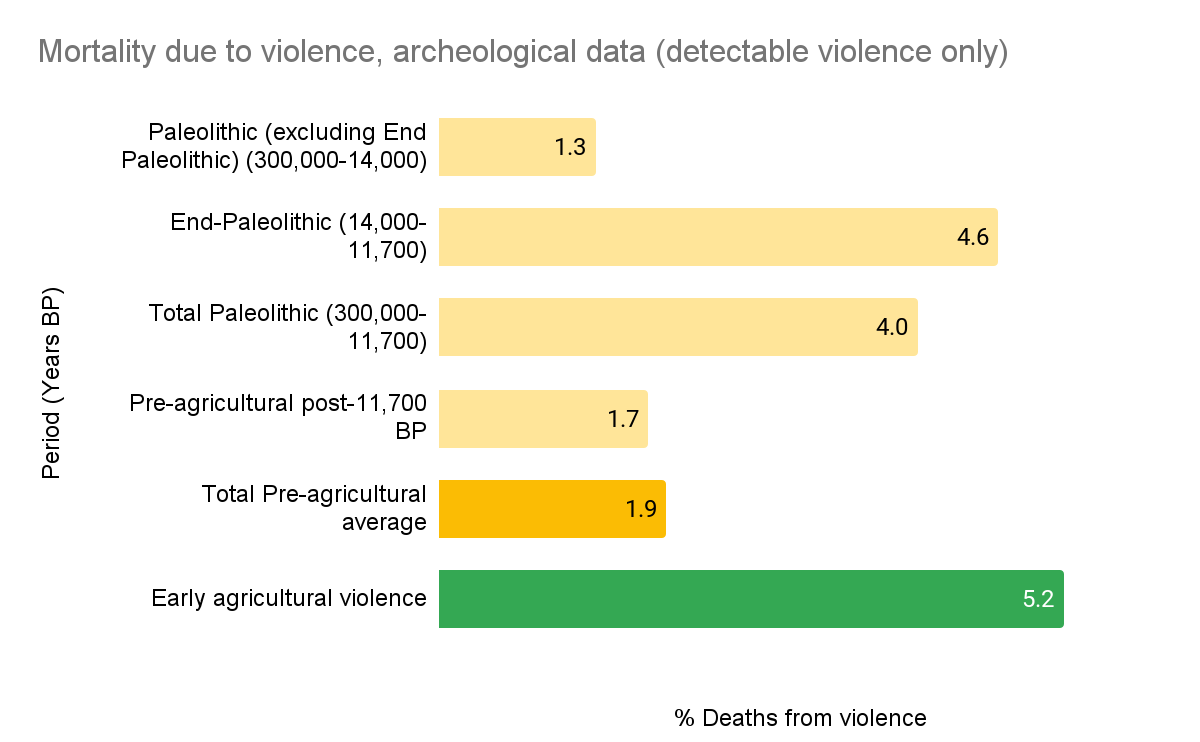
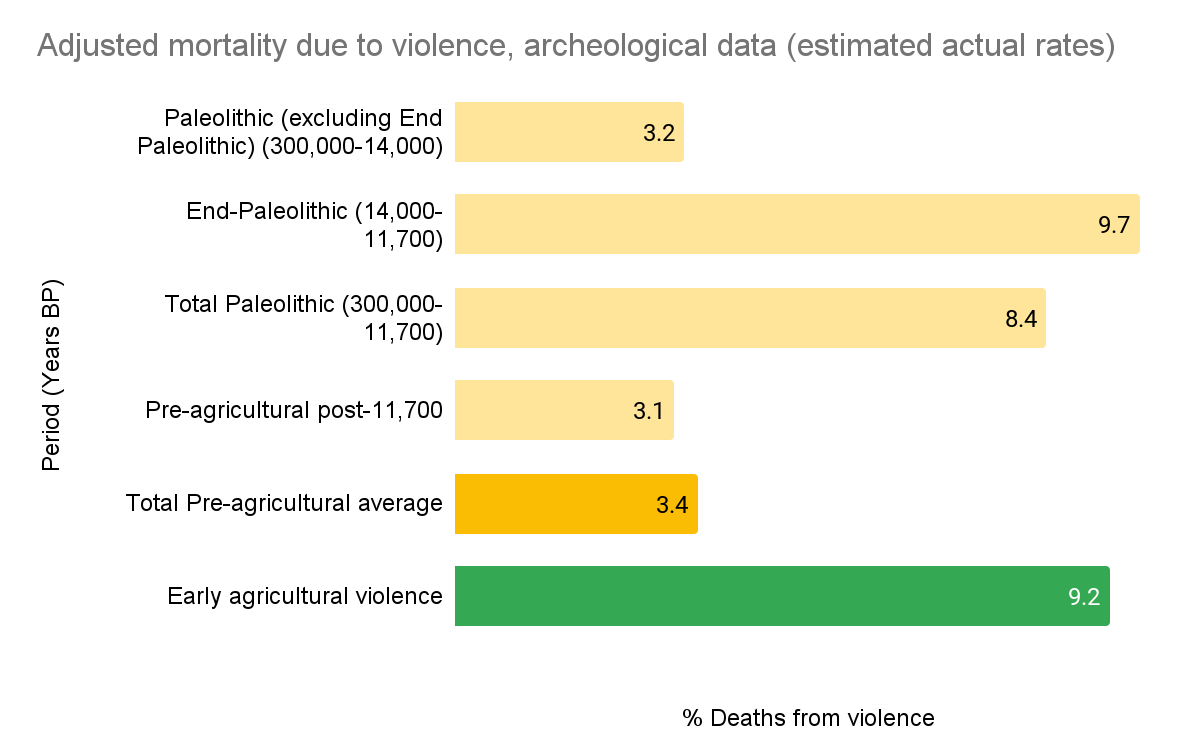
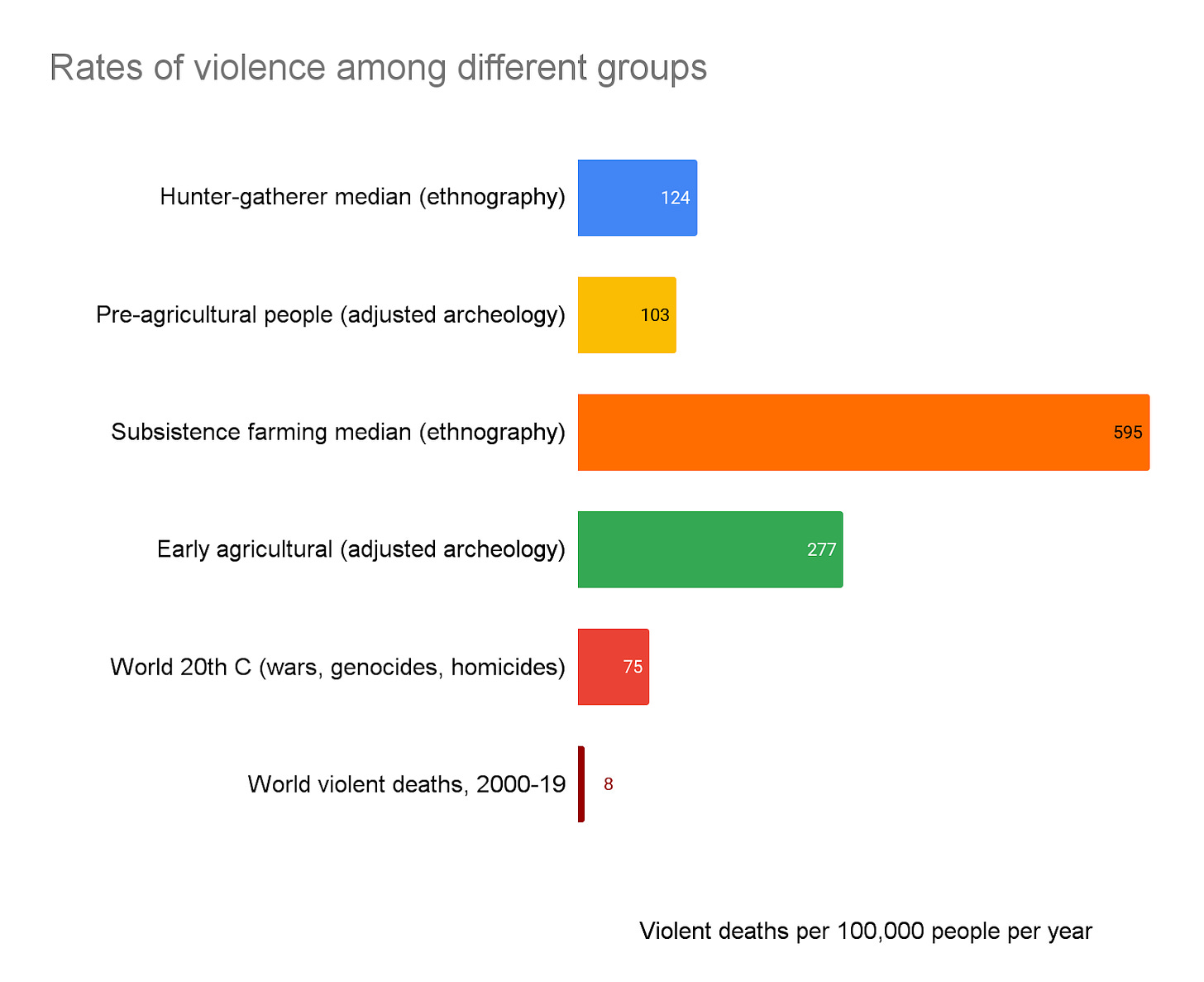
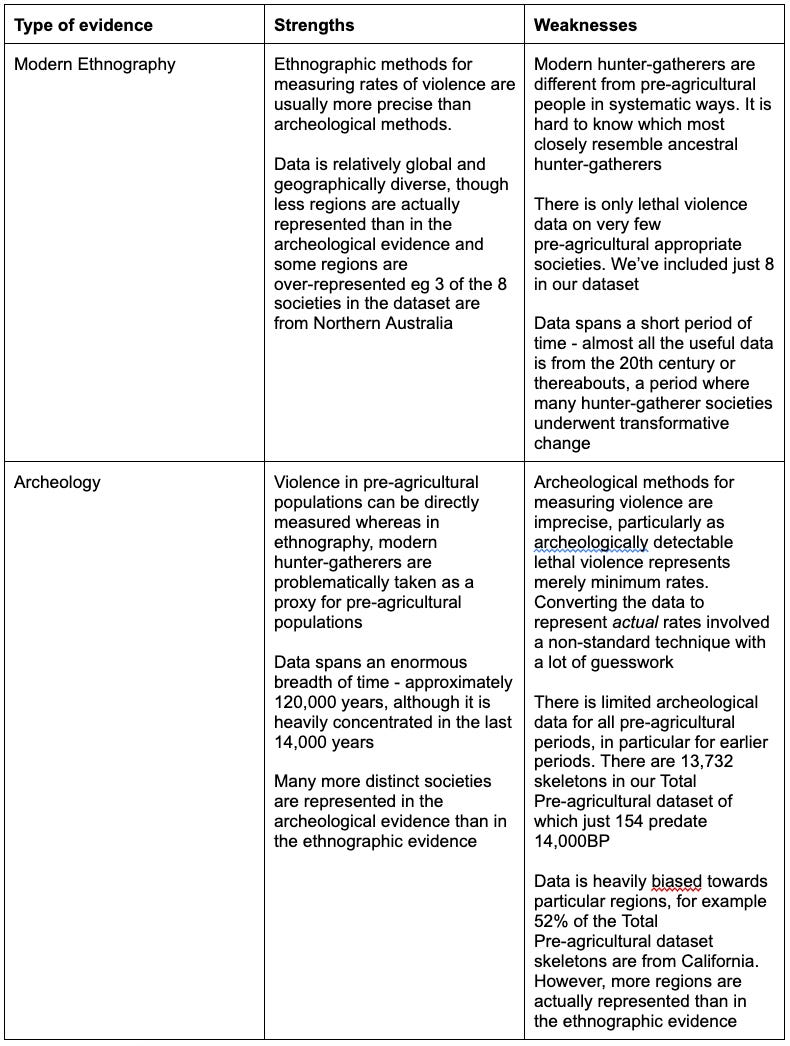
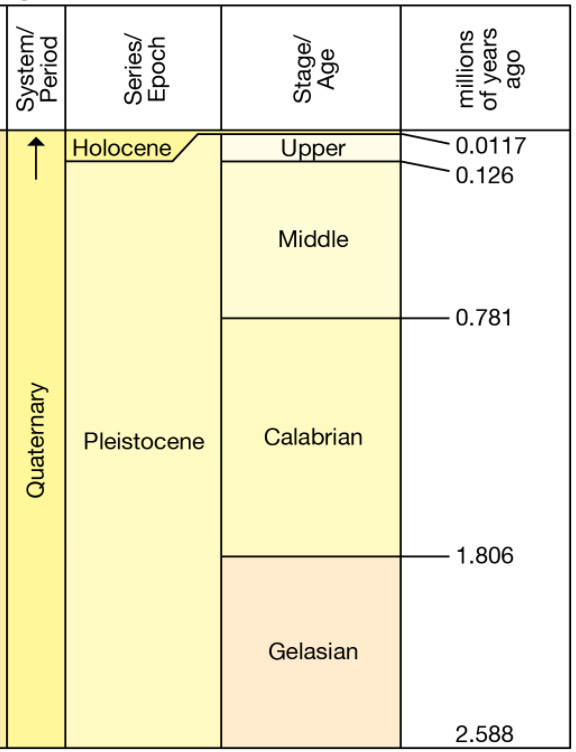


This report seems commendably thorough and thoughtful. Could you possibly spell out its implications for effect altruists though? I take it the conclusion is that humanity was most violent in the subsistence farming period, rather than before or after, but I'm not sure what to make of that. Presumably, it shows how violent people are changes quite radically in different contexts, so should I be reassured if, as seems likely, modern-type societies will continue? Returns to hunter-gathering and subsistence farming do not seem on the cards.
Sorry if I've missed something. But I reckoned that, if it was obvious to me, some others would missed it too.
I think it's mainly relevant for the part of EA that is interested in long-run history and its implications for the long-term. There's also some stuff in the discussion about how the drivers of conflict are a small subset of sociopaths/malevolent people; humanity is not innately violent even though we have high rates of violence relative to other primates. I think is relevant for the future of violence.
The links to the spreadsheets don't work (maybe it isn't publicly shared?)
Yeah I've realised my old google account where that was kept has been deleted. I'll figure out whether I can get it back somehow
I have a copy of it here: https://docs.google.com/spreadsheets/d/1nlBKzkTHzDDqHka-CvWybF8rqXivEA3_FrwhtTosDCA/edit?usp=sharing
(you'll probably want to make your own copy of this, as I might add stuff to this spreadsheet one day)
joao you're my hero. the prospect of redoing the spreadsheet fillled me with dread
I've now updated the link for the spreadsheet which should work